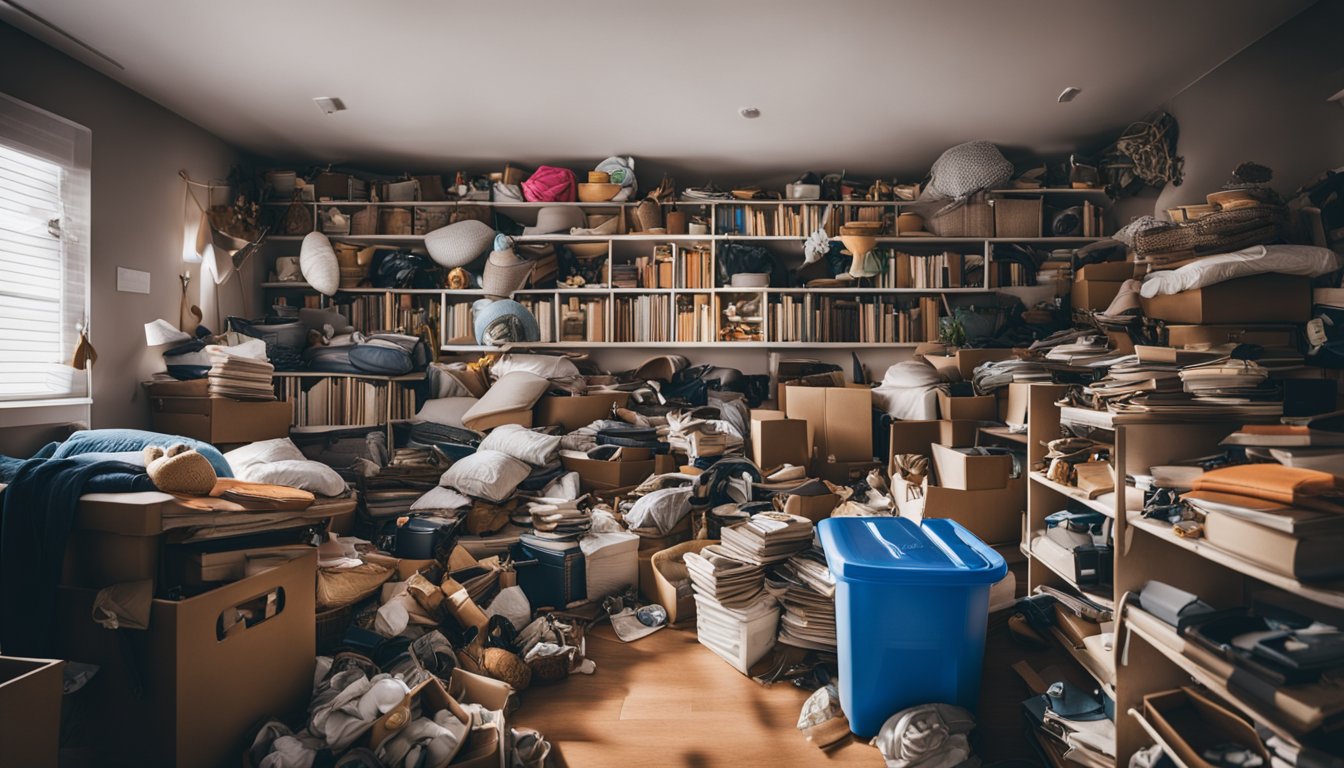The #1 Mistake Homeowners Make When Decluttering Their Homes (With 4 Strategies That Work)
Decluttering your home isn’t just about creating more space—it’s about crafting a more peaceful and functional environment. While the end result is a cleaner, more organized home, the road to get there is often fraught with obstacles and missteps.
One of the most common pitfalls is jumping headfirst into the process without a clear strategy.
In this post, we’ll dive into the #1 mistake homeowners make when they begin to declutter their homes and provide actionable advice to help you sidestep this error and achieve your decluttering goals with confidence.
The #1 Mistake: Not Planning or Using a Systematic Approach
The excitement of envisioning a clutter-free home can lead many to tackle the task with gusto, only to quickly find themselves in over their heads.
The #1 mistake made by homeowners during the decluttering process is the absence of a clear plan or systematic approach. It’s like setting off on a journey without a map—without direction, it’s easy to get lost.
Statistics show that the average American home contains over 300,000 items, from paper clips to dining chairs. With such an overwhelming number of possessions, it’s no wonder that diving into decluttering without a plan can lead to quick burnout and frustration. The key to avoiding this pitfall is not just to start, but to start with intention.
Without a plan, you may find yourself moving items from one room to another, trying to tackle too much at once, or becoming emotionally drained by the decisions you need to make about what stays and what goes. This lack of structure not only diminishes your productivity but can also leave you with a home that’s just as cluttered as when you started—if not more so.
Practical Tip: Before you begin, take a moment to visualize the end result. What does a decluttered space look like for you? How will it improve your daily life? Keeping this vision in mind can help you stay focused and motivated throughout the process.

Consequences of Not Planning or Using a Systematic Approach When Decluttering
When homeowners begin decluttering without a plan, they often don’t anticipate the challenges ahead. This oversight can lead to several negative outcomes.
For instance, without a clear strategy, decluttering can quickly become overwhelming, leading to a phenomenon known as ‘decluttering fatigue.’ This is a state of feeling exhausted and stressed by the sheer amount of decisions and physical work involved in the process. It’s a significant issue, as it can cause homeowners to give up entirely, leaving the task unfinished and the home in disarray.
Another consequence of this mistake is the cycle of clutter. Without a systematic approach, items may be shuffled around rather than being properly sorted and organized. This can result in ‘clutter hotspots’ re-emerging soon after they’ve been cleared, causing frustration and the sense that no progress is being made. It’s a disheartening experience that can make the goal of a tidy, organized home feel out of reach.
Practical Tip: To avoid these outcomes, set small, achievable goals for each decluttering session. For example, rather than aiming to declutter an entire room in one day, focus on a single closet or drawer. This approach not only makes the task more manageable but also provides a sense of accomplishment that can motivate you to continue.
How to Avoid the #1 Mistake Homeowners Make When Decluttering
The antidote to the #1 mistake is simple: planning. Creating a decluttering plan is like drawing a map for your journey to a clutter-free home. It provides direction, helps you set goals, and breaks down the process into manageable steps.
Here’s how to craft a plan that will guide you through decluttering with ease:
- Set Clear Goals: What do you want to achieve with decluttering? Are you looking to reduce your belongings by a certain percentage, create more space in a particular room, or prepare for a move? Having clear objectives will help guide your decisions and keep you on track.
- Pick a decluttering strategy and stick to it: We’ll cover these below – having a specific plan of action can be incredibly helpful to get you moving right away.
- Categorize Your Items: Start by categorizing items into groups such as ‘keep,’ ‘donate,’ ‘sell,’ and ‘discard.’ This will make it easier to decide what to do with each item and prevent you from moving things aimlessly around your home.
- Schedule Decluttering Sessions: Decluttering is a marathon, not a sprint. Schedule regular, timed sessions for sorting and organizing. Whether it’s 15 minutes a day or a few hours each weekend, consistent effort will yield results.
- Be Patient and Take Incremental Steps: Remember that decluttering doesn’t happen overnight. Be patient with yourself and recognize that small steps add up to significant change over time.
Practical Tip: Use a checklist or a decluttering app to keep track of your progress. This can help you stay organized and give you a visual representation of what you’ve accomplished, which can be incredibly satisfying and motivating.

Common Decluttering Strategies
Once you have a plan in place, integrating proven decluttering strategies can help streamline the process. Here are some popular methods that, when used in conjunction with your plan, can make decluttering more manageable and effective:
- KonMari Method: Popularized by Marie Kondo, this method involves keeping only those items that “spark joy.” It encourages a category-by-category approach to decluttering, starting with clothes, then moving on to books, papers, komono (miscellaneous items), and, finally, sentimental items.
- Four-Box Method: This simple yet effective technique involves using four boxes to determine the fate of each item: keep, donate, sell, or trash. As you go through your belongings, you’ll place each item into one of the boxes, which helps to quickly categorize and make decisions.
- One-Minute Rule: For everyday decluttering, the one-minute rule is a practical approach. If a task takes one minute or less to complete—like hanging up a coat or filing a document—do it immediately. This habit can prevent small amounts of clutter from accumulating into larger messes.
- 12-12-12 Challenge: This is a fun and engaging way to declutter. Find 12 items to throw away, 12 to donate, and 12 to be returned to their proper place. It’s a quick way to declutter 36 items and can be turned into a game for the whole family.
Practical Tip: Don’t be afraid to customize these strategies. For instance, if the KonMari Method’s category sequence doesn’t suit you, feel free to adjust the order. The goal is to make decluttering work for you, not to follow a system rigidly.

Tips and Best Practices for Effective Decluttering
To complement your plan and chosen strategies, here are some additional tips and best practices that can make decluttering even more effective:
- Start with Easy Wins: Begin with areas of your home that are less sentimental and easier to declutter. This could be the bathroom, the laundry room, or your kitchen utensils. The quick progress you’ll make can boost your confidence and motivation.
- Use the ‘One In, One Out’ Rule: To maintain a clutter-free home, adopt the ‘one in, one out’ rule. For every new item you bring into your home, ensure an existing item is sold, donated, or discarded. This helps to prevent new clutter from accumulating.
- Donate Regularly: Set up a box for donations and add to it regularly. Once it’s full, take it to a local charity. This not only helps you keep your home clutter-free but also supports your community.
- Visualize Your Space: Keep a picture of a decluttered room or area that inspires you. When you feel overwhelmed, look at this image to remind yourself of your goals and the serene space you’re working towards.
- Involve the Household: Decluttering is more effective and enjoyable when everyone in the home is involved. Assign tasks based on age and ability, and make it a team effort.
Practical Tip: Celebrate your decluttering milestones, no matter how small. Whether it’s clearing out a single drawer or an entire closet, acknowledging your progress can provide a sense of achievement and keep you motivated.

Conclusion
We’ve explored the #1 mistake homeowners make when decluttering their homes—starting without a plan—and delved into the importance of having a clear, systematic approach to avoid feeling overwhelmed and to achieve lasting results. We’ve also touched on some popular decluttering strategies and provided practical tips to enhance your decluttering efforts.
Remember, the goal of decluttering isn’t just to reduce the number of items in your home; it’s to create a space that feels peaceful and brings joy. By avoiding the pitfall of decluttering without a plan, you set yourself up for success from the start. With each item you sort, each drawer you organize, and each piece you let go, you’re not just clearing physical space—you’re also making room for new possibilities in your life.
Let Us Know How We’re Doing!
Did this expertly prepared resource answer your question?
Do you have another question about home maintenance, home improvement projects, home appliance repair, or something else?
Get more information, send in questions and keep the discussion going by contacting the I’ll Just Fix It Myself company customer service team at at 1-800-928-1490 or Email us at [email protected]
